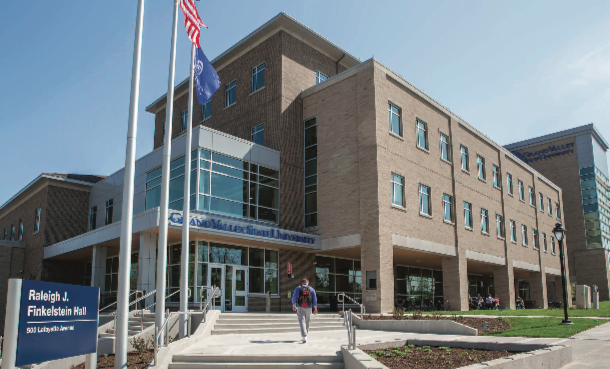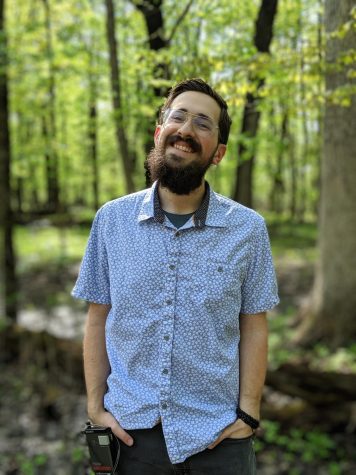GVSU Art Gallery fills new Finkelstein Hall with more than 280 pieces of art
The five-story building houses 16 teaching laboratories and 90 faculty and staff offices. Courtesy / Grand Valley State University
Aug 21, 2018
Extensive directional meetings, selecting art out of a sizeable collection and installing over 280 pieces of artwork may seem daunting, but it’s standard work for Grand Valley State University’s Art Gallery. Their latest masterpiece involved filling the halls of the newly completed Raleigh J. Finkelstein Hall, a canvas that gave way to floors of powerful, themed art.
With buildings being constructed and renovated every year, Art Gallery Project Manager Alison Christensen said that the gallery is always busy over the summer. Despite that, the process to select art is a lengthy one that begins with one goal in mind: to choose pieces from GVSU’s collection that serves the needs of the students.
“We really try to make sure that whatever artwork is going into the building can be utilized for the students and that it relates to the programs that are happening inside the building,” Christensen said. “It should work for how students may use the art in those spaces.”
For Finkelstein Hall, an initial art advisory committee formed to determine criteria for artwork to be featured just over one year ago. The committee, which included members of the Art Gallery, determined the various artistic themes featured on each floor.
“The halls of the lower level, which focus on sonography and cardiovascular sciences, feature artwork with imagery based off of those fields; the committee selected work that is inspired by these sciences, not direct depictions,” Christensen said. “The first floor is full of windows, exposing the community, so art was selected to reflect local artists and GVSU’s new presence in the neighborhood.”
The art for the second floor features California artist Ted Meyer, who partners with medical patients to create prints using ink and their scars. Christensen said a committee member brought up his work and the team was inspired by his storytelling.
“(Meyer’s work) helps students see different types of patients, understand their story, and I also really like these works of art because it was a partnership between the medical patient and the artist rather than the patient being objectified,” Christensen said. “They both wanted to be able to have their stories of their medical conditions displayed in an artistic way.”
The third floor houses observational labs, where children will make up the majority of patients. The art reflects this, with some art being purchased from the neighboring Coit Creative Arts Academy. GVSU selected art created by students, with profits allowing their teachers to purchase school supplies.
Juxtaposed to this work is art from a GVSU charter school in Flint, where students reflect on the effects of the city’s water crisis.
“(The pieces) are pretty powerful because younger kids don’t really hold back what they’re feeling,” Christensen said. “It’s a serious topic but a very approachable way to think about that crisis and how we can make improvements moving forward.”
While the fourth floor is mostly offices and collaborative spaces, it also features an expansive view of the surrounding neighborhood. Working with the Grand Rapids archives, the gallery printed historic images of the surrounding Belken neighborhood.
“Since Grand Valley is a new neighbor in this neighborhood, we wanted to be able to show the growth in the neighborhood and promote the idea that we’re part of the growth,” Christensen said.
While the total number of pieces of art installed may seem immense on paper, head preparator Andrew King said that it’s what he has been doing annually for Grand Valley since 2003.
King and his team prepare works with UV reflecting glass and mount them to protect the variety of 2D and 3D works on display. For the Finkelstein Hall project specifically, King said he was on board from the very beginning of discussions, with the final instillation taking three weeks.
“Usually, we’re so exhausted by that point that once it’s on the wall, we’re happy,” King said. “But if everything looks good and nothing is damaged, that’s success.”
With every project – whether it be a renovation or new construction – the art the fills each building is meant to be meaningful and intentional. While the art itself may be beautiful, it mostly provides the tools that allow students to see worldly, inspiriting perspectives.
























